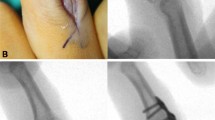Abstract
The aim of this study is to investigate the clinical outcomes of various fixation methods for proximal phalangeal fractures with Arbeitsgemeinschaft für Osteosynthesefragen (AO) mini titanium plate by dorsolateral approach or post-middle approach. Clinical results of 62 fingers of 53 patients with proximal phalangeal fracture were evaluated. For dorsolateral approach, the lateral bundle of the extensor tendon was drawn away to expose the fracture part of the bone. After reduction, the plate was located at the dorsolateral side of the bone. For post-middle approach, the extensor tendon was split to expose the fracture part of the bone. After reduction, the plate was fixed to the proximal phalangeal side of the bone, and the extensor tendon was repaired with 3-0 nonabsorbable silk sutures. We found low overall complication rates in both groups. The mean total active motion (TAM) for the dorsolateral group and post-middle group was 234.60° ± 22.63° and 221.08° ± 25.69°, respectively. There was a statistical significance between the two groups (P = 0.037 < 0.05), indicating that TAM was notably affected by various fixation methods. With AO mini titanium plate, movement in dorsolateral approach group was significantly higher than in post-middle approach group. Dorsolateral approach is an acceptable technique of incision for proximal phalangeal fractures.

Similar content being viewed by others
References
Emmett JE, Breck LW (1958) A review and analysis of 11, 000 fractures seen in a private practice of orthopaedic surgery, 1937–1956. J Bone Joint Surg Am 40:1169–1175
Drenth DJ, Klasen HJ (1998) External fixation for phalangeal and metacarpal fractures. J Bone Joint Surg Br 80:227–230
Barton N (1989) Conservative treatment of articular fractures in the hand. J Hand Surg Am 14:386–390
Wright TA (1968) Early mobilization in fractures of the metacarpals and phalanges. Can J Surg 11:491–498
Kawamura K, Chung KC (2006) Fixation choices for closed simple unstable oblique phalangeal and metacarpal fractures. Hand Clin 22:287–295
Margic K (2006) External fixation of closed metacarpal and phalangeal fractures of digits. A prospective study of one hundred consecutive patients. J Hand Surg Br 31:30–40
Safoury Y (2001) Treatment of phalangeal fractures by tension band wiring. J Hand Surg Br 26:50–52
Meunier MJ, Hentzen E, Ryan M, Shin AY, Lieber RL (2004) Predicted effects of metacarpal shortening on interosseous muscle function. J Hand Surg Am 29:689–693
Freeland AE, Orbay JL (2006) Extraarticular hand fractures in adults: a review of new developments. Clin Orthop Relat Res 445:133–145
Souer JS, Mudgal CS (2008) Plate fixation in closed ipsilateral multiple metacarpal fractures. J Hand Surg Eur 33:740–744
Agarwal AK, Pickford MA (2006) Experience with a new ultralow-profile osteosynthesis system for fractures of the metacarpals and phalanges. Ann Plast Surg 57:206–212
Pun WK, Chow SP, So YC, Luk KD, Ngai WK, Ip FK et al (1991) Unstable phalangeal fractures: treatment by A.O. screw and plate fixation. J Hand Surg Am 16:113–117
Omokawa S, Fujitani R, Dohi Y, Okawa T, Yajima H (2008) Prospective outcomes of comminuted periarticular metacarpal and phalangeal fractures treated using a titanium plate system. J Hand Surg Am 33:857–863
Wilson-Jones N, Laing H (2006) Acute injuries to the flexor and extensor tendons of the hand. Orthopaedic III: injuries to the upper limb. Surgery 24:441–445
Soni A, Gulati A, Bassi JL, Singh D, Saini UC (2012) Outcome of closed ipsilateral metacarpal fractures treated with mini fragment plates and screws: a prospective study. J Orthop Traumatol 13:29–33
Barton NJ (1984) Fractures of the hand. J Bone Joint Surg Br 66:159–167
James JIP (1962) Fractures of the proximal and middle phalanges of the fingers. Acta Orthop Scand 32:401–412
Horton TC, Hatton M, Davis TR (2003) A prospective randomized controlled study of fixation of long oblique and spiral shaft fractures of the proximal phalanx: closed reduction and percutaneous Kirschen wiring versus open reduction and lag screw fixation. J Hand Surg Br 28:5–9
Greene TL, Noellert RC, Belsole RJ, Simpson LA (1989) Composite wiring of metacarpal and phalangeal fractures. J Hand Surg Am 14:665–669
Chen SH, Wei FC, Chen HC, Chuang CC, Noordhoff S (1994) Miniature plates and screws in acute complex hand injury. J Trauma 37:237–242
Trevisan C, Morganti A, Casiraghi A, Marinoni EC (2004) Low-severity metacarpal and phalangeal fractures treated with miniature plates and screws. Arch Orthop Trauma Surg 124:675–680
Gupta R, Singh R, Siwach R, Sangwan S, Magu NK, Diwan R (2007) Evaluation of surgical stabilization of metacarpal and phalangeal fractures of hand. Indian J Orthop 41:224–229
Zyluk A, Budzynski T (2006) Treatment of metacarpal and phalangeal fractures—a review. Chir Narzadow Ruchu Ortop Pol 71:299–308
Lu WW, Furumachi K, Ip WY, Chow SP (1996) Fixation for comminuted phalangeal fractures. A biomechanical study of five methods. J Hand Surg Br 21:765–767
Galuppo LD, Stover SM, Willits NH (2000) A biomechanical comparison of double-plate and Y-plate fixation for comminuted equine second phalangeal fracture. Vet Surg 29:152–162
Acknowledgments
This work was financially supported by the National Natural Science Foundation of China (no. 31071228) and Shanghai Municipal Natural Science Foundation (no. 09ZR1416400).
Author information
Authors and Affiliations
Corresponding authors
Additional information
Guang Li and Shen Liu contributed equally to this work.
Rights and permissions
About this article
Cite this article
Li, G., Liu, S., Chen, G. et al. Comparison of Clinical Outcomes of Phalangeal Fracture Treated with Dorsolateral Approach or Post-middle Approach Using AO Mini Titanium Plate. Indian J Surg 77 (Suppl 2), 657–661 (2015). https://doi.org/10.1007/s12262-013-0968-3
Received:
Accepted:
Published:
Issue Date:
DOI: https://doi.org/10.1007/s12262-013-0968-3




